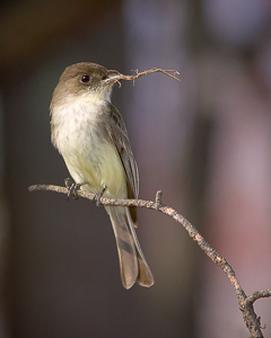EASTERN PHOEBE MO-150
Prairie State Park, Mindenmines, Missouri
June 2, 5:31 a.m.
Sunrise at 5:58 a.m.
An eastern phoebe at dawn. In this selection, he sings at clip of 18 songs for the first 30 seconds, 36 songs per minute, and he mostly alternates his two song forms. At only one place in the first minute do two FEE-bee songs occur back to back (beginning at 0:21). Feel the subtle difference in timing, how the shortest interval between songs is typically from FEE-bee to the stuttered FEE-b-b-be.
We can do more than feel. Let's measure some time intervals, beginning at 0:18. Here are the times for the following types of intervals:
1) from FEE-bee to the stuttered FEE-b-b-be: 0.96, 1.21, 0.82, 0.94 seconds
2) other intervals: 1.47, 1.37, 1.59, 1.32 seconds
The numbers tell how he hustles from his FEE-bee to the stuttered FEE-b-b-be (average of 0.98 seconds), but takes a little more time in the other transitions (1.44 seconds). Both the songs and this timing are the essence of all eastern phoebe singing, as each bird knows these fundamentals by information encoded in its DNA--it does not have to be learned from adults.
Background
Gray catbird, yellow-breasted chat, at 0:50 a frog begins warming up, eastern towhee, indigo bunting, northern cardinal, and two very different frog sounds (compare the staccato calling from 0:50-1:46 to the whimpering calls heard at 4:18 and 4:45).

Photo by Wil Hershberger
